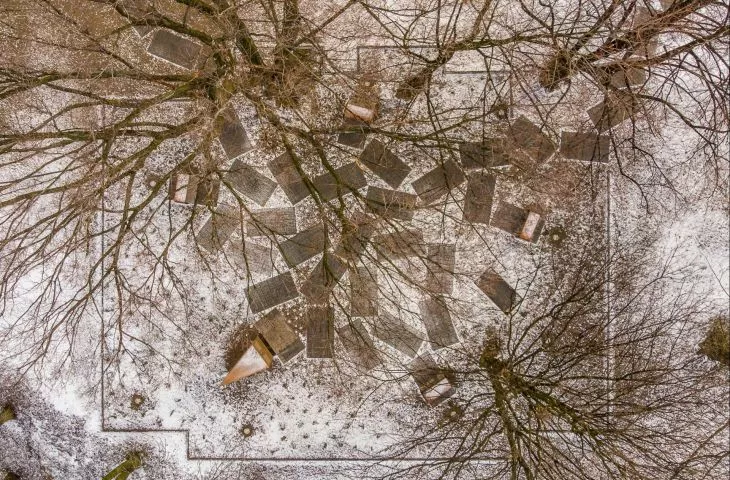In Oswiecim, architects from the NArchitekTURA studio have designed a unique space - the Great Synagogue Memorial Park. What is unusual about this project is not only the symbolic dimension, recalling the shape of the now-defunct synagogue, but also the material used for its implementation - grooved slabs of gray sandstone, an industrial waste, which, thanks to its use in the Memorial Park, has not been written off.
Ola Kloc: The symbolism of the project is multifaceted, what was your main intention?
Bartosz Haduch (NArchitekTURA): The Memorial Park of the Great Synagogue in Oswiecim can be seen as a continuation and development of our earlier realization of the interior design and permanent exhibition of the Jewish Center there. Working on this long-term project was an opportunity for us to delve into the previously unknown secrets of the unique history associated with this place, but also with pre-war Poland. The process of gradually learning about and understanding a new culture is always very valuable to us, and each time it influences the architecture we create in a different way. We have already designed in such "exotic" places as Mozambique, Mali, Morocco, China and Japan, and each time our concepts have been firmly rooted in the local context - however, we do not rely on literal quotations, but more on various renditions of contemporary interpretations in order to adequately capture and perpetuate the genius loci.
The main element of the park development is a mosaic of forty slabs of gray sandstone
photo: Piotr Strycharski
In the Auschwitz Memorial Park, the dimensions, shapes and colors of the forms used are linked not only to Jewish tradition, but also to universal symbolism, legible within different faiths and cultures. The space is open-ended and allows for a variety of uses, commemorations and interpretations. References to the temple that was demolished eighty years ago appear in various forms in the new design. The outline of the former synagogue's projection is marked by a narrow curb, separating the interior of the park from the surrounding dense greenery. The main entrances are aligned with the nearby thoroughfares and frame the urban dominants - the Church of the Assumption of the Blessed Virgin Mary and the Shrine of Our Lady Help of the Faithful. The entire establishment opens up to the picturesque panorama of the Soła River boulevards. The main element of the park development is a mosaic of forty slabs of gray sandstone. Their irregular arrangement is meant to symbolize the remains of the former synagogue (its floor was made of similar material). The slabs lead to individual elements of the park - a display depicting the history of the synagogue (stylistically reminiscent of the earlier Oshpitzin Jewish Center project), a "well" with a historical floor (planned for the next stage of the project), a water pond, corten metal benches and a chandelier (which is a copy of an artifact found at the site during archaeological work).
Memorial Park, spring
Photo: Piotr Strycharski
Ola: How did you come up with the idea to use slabs of post-industrial waste in the project?
Bartosz: Almost a decade ago, I came across a beautiful industrial waste by accident - slabs of gray sandstone with countless irregular cuts. For many years I searched for a design suitable for this unusual material. I succeeded in Oświęcim, where it became the main motif of the Memorial Park, symbolizing the ruins of the now defunct Great Synagogue (1863-1939) and the paths of life of the multicultural community, once intersecting there.
The illustration of the idea of "paths of life" manifests itself mainly in the form of a unique material solution. Modules of gray sandstone, measuring 120×220 cm, are decorated with "reliefs" composed of countless grooves of varying depths. These lines cut into the stone form a kind of unique "reliefs", changing their image depending on the angle of light and its intensity, or weather conditions - rain, snow, etc. Interestingly, this geometric pattern is not the result of the work of architects using the latest technology, but largely the work of chance. At the quarry, these slabs served as bases for cutting smaller formats, and no one had previously come up with the idea of using them in construction. They are industrial waste, reused and "brought back to life" - so to speak, as a gesture against the overexploitation of natural resources.
The used slabs served in the quarry as bases for cutting smaller formats
photo left photo: Piotr Strycharski, photo right photo: Bartosz Haduch
Ola: The design of the Great Synagogue Memorial Park is full of humility, it doesn't impose anything on the viewer. Weren't you tempted to create something that would be more iconic?
Bartosz: I think succumbing to the right temptations and giving up the wrong ones is a difficult but important skill - not only in architecture [laughs].
In Memorial Park, our intervention gives way to nature, which has gradually appropriated the place over several decades. Today it is the crowns of the trees that form a vault over the place where the Great Synagogue once stood and give the illusion of an interior - limited, however, not by the elements of architecture, but by the landscape.
Ola: Thank you for the interview!

































